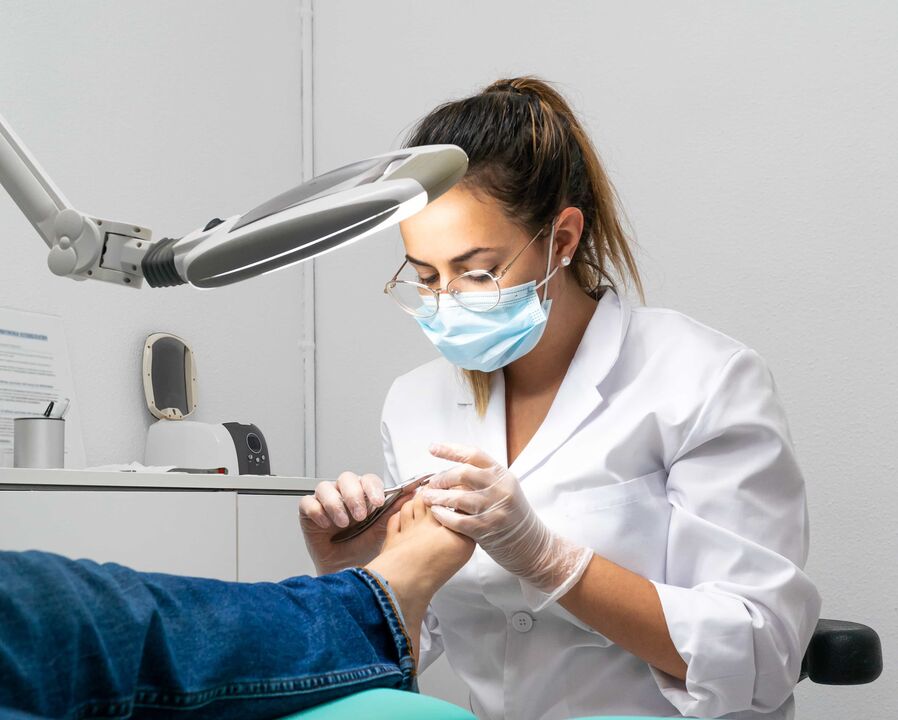Nail fungus is diagnosed in 20-30% of people. The disease is much more difficult to treat than fungal skin infections. To achieve a good treatment effect, systemic and topical antifungal drugs should be used for 18 months or more. In some cases, repeated treatments are required.

Nail fungus treatment
Causes of fungal nail infections, classification, pathogenesis
Onychomycosis is an infectious disease that manifests itself as damage to the nail plate due to invasion of fungal flora. It can occur in both fingernails and toenails.
Damage to the nail plates is caused by the following pathogens:
- lesions of the feet - dermatomycetes, candida albigens, non-dermatomycete molds;
- nail fungus - dermatomycetes, C. parapsilosis, mold.
The nail complex can be affected by one fungal agent or 2-3 types of pathogens at the same time.
Pathological factors:
- age over 50 years old;
- Long-term work at dangerous jobs worsens immune status;
- Frequent sweaty feet due to improper shoe selection;
- traumatic damage to the nail complex, stimulating the inflammatory process and the growth of pathogenic bacteria;
- Immunodeficiency causes tumor progression, autoimmune disease, diabetes, and other conditions;
- dystrophy of the nail plates in dermatological diseases.
All these factors can lead to the appearance of fungal infections.
Symptoms and pathological stages in adult patients
Onychomycosis is localized in the fingers or toes. The clinical picture of the disease is manifested by changes in color, transparency and shape of the nail plate. Symptoms of fungal infections can vary depending on the type of condition. The following types of onychomycosis are distinguished:
- Marginal damage is the first initial stage of pathology, caused by pathogens entering from the outside; Almost imperceptible changes in the nail plate appear in the area of its free part, not adjacent to the nail bed; with yellow-gray stripes and patterns (areas of nail abrasion).
- Normal variety - the nail plate has stripes or damaged parts, but at the same time retains its original thickness and shape; Nails become brittle and gray-yellow; plates become thinner and grow more slowly.
- Hypertrophic appearance - observed in patients with untreated onychomycosis; thickening of the nail plate in the area of the free part of the nail or at the location of the nail folds; They also highlight the complete deterioration of the sheet as it changes color, transparency and thickness uniformly.
- White superficial variety - occurs more often after prolonged treatment with systemic antifungal drugs; Appears as white or yellowish blotches on the nail surface.
- The appearance is almost deformed - the nail plate has a wave-like shape (similar to a washboard), the color and transparency remain the same.
- Onycholytic variety - plates become fragile, brittle, thin; occurs against the background of a hypertrophic or normal onychomycosis.
- Atrophic type - thin, brittle nails; appears when the plate is regularly polished.
Based on the clinical picture, the doctor determines the type of pathology, makes a diagnosis and prescribes treatment.
Manifestations of fungus in childhood
Symptoms of onychomycosis in children are most often observed when the skin of the feet and hands is affected by fungus. Nail changes:
- The normal type of disease is manifested by degeneration of the plate with normal thickness and shape. Young patients' nails become ridged, dull, and yellow-white. The sheet begins to peel off in the sole area.
- Leukorrhea - looks like small spots that merge over time and cover the entire nail surface.
- Type of nail atrophy and detachment - the nail begins to separate from the nail bed and shorten.
- Distant mycosis - the appearance of transverse grooves of a brownish color (tunnels created by the pathogen).
Hypertrophic and proximal (waveform deformity) types of disease are rare in children.
Advanced nail fungus - what are the possible complications?
Infection can spread to all parts of the body (neck, trunk, arms, legs), if the patient has weakened immunity or has chronic diseases (diabetes mellitus, thyroid disease). ). A general course is provoked by prolonged absence from treatment.
Deformity of the nail is often accompanied by its growth into the lateral folds of the nail bed. This condition requires surgery because it causes severe pain and swelling.
Which doctor should I go to for nail fungus treatment?
If symptoms of onychomycosis appear, you should see your doctor. Your doctor will conduct an examination and refer you to a dermatologist or podiatrist. You cannot treat the disease yourself or ignore its symptoms, as this can lead to serious deformation of the nail plate. A marked change in the shape of the nail requires surgical treatment.

If you suspect a fungus, consult your doctor
Diagnostic method
For diagnosis, it is necessary to confirm the presence of a fungal agent in the nail plate. For this purpose, the microscopic method is used. A piece of material is taken from the patient from the rest of the nail, the nail itself and the subungual area. If a pathogen is identified, the material will be resampled for testing. If the fungus is detected again, treatment will be initiated.
In some cases, seeding is indicated. It is performed more often after a course of treatment. Culture shows the ability of the fungus to cause recurrence.
In addition to culture and microscopy, before treatment with antifungal drugs, the patient may be prescribed:
- General blood tests, urine tests,
- Liver enzymes,
- alkaline phosphatase,
- bilirubin,
- TSH.
These studies will help identify chronic diseases and prevent complications that can occur when taking medications.
How do podiatrists or dermatologists treat nail fungus?
Treatment of nail fungus should be done promptly. Therapy is prescribed after diagnosis. To increase the effectiveness of treatment, you must follow all your doctor's recommendations. Otherwise, the possibility of disease recurrence is very high.
Complex therapy includes systemic medications to treat nail fungus as well as topical medications that help relieve symptoms faster.
Systemic therapy includes antifungal medications administered in tablet and capsule form. They enter the bloodstream, destroying the fungal agent from the inside. Systemic therapy, done properly, will prevent recurrence because it blocks the source of infection.
Local preparations are applied directly to the nail plate. They improve the appearance of the nails, locally destroy fungal spores and promote rapid regeneration of the nails.
In addition to local and systemic therapy, surgery or cosmetic correction is indicated in severe cases. Surgical treatment is indicated more often for inflammation after ingrowth of the nail plate. Cosmetic correction is used when the nail is severely deformed.
Attention! Nail fungus should not be treated with folk remedies. This can lead to complications.
Top most effective ways to treat fungus
Topical therapies are less effective and are often combined with systemic medications. Topical treatments for nail fungus include:
- ointment,
- cream,
- varnish.
To use topical medication, you must first remove the affected parts of the nail plate. For this purpose, keratolytic patches are indicated. They are divided into:
- Urea.
- Salicylic (Quinozolo-salicylic patch, Quinozolodimexide patch).
Sometimes the affected nail plates are removed by cleaning (removing hardware with diamond cutters and other methods).
After removal of the affected nail, topical therapy begins. If the nail plate is preserved after softening or mechanical cleaning, apply varnish. The most common of this group of external agents are drugs with the following substances:
- Amorolfine, prescribed for application twice a week; The course of treatment is six months (arms), one year (legs).
- The active ingredient is ciclopirox; Apply every day during the first month, then in the second month of treatment it is prescribed once a week; The course lasts up to six months.
In addition to varnishes, it is allowed to use creams and ointments. Effective substances:
- Clotrimazole in ointment or cream form;
- Bifonazole - in the form of cream, spray;
- Ketoconazole and other medications.
Ointments or creams for nail fungus containing Terbinafine are commonly used. The effectiveness of this product is quite high.
Forecast
The prognosis for timely treatment is favorable. Proper treatment can completely eliminate the symptoms of the disease. If the pathology is not treated, severe deformation of the nail plate and spread of infection to the skin may occur.
How to prevent the appearance of pathology
The occurrence of onychomycosis can be prevented by following simple hygiene rules. You should bathe every day and dry your feet with a towel. You should clean the bathroom or shower room with antiseptic solution and change your clothes (especially socks and tights). Products containing chlorine are recommended for treating wet rooms.
You should avoid going to public baths or saunas or wearing personal shoes with you, this will reduce the possibility of infection. For prevention, it is allowed to use antifungal sprays after the examination.
Pathogens can be transmitted on the beach. Therefore, after a beach vacation, you should wash your feet, treat them with antifungal sprays or other external preparations.
You can not wear someone else's shoes or socks - this can be a source of infection. When trying on shoes or boots in the store, you must wear ankle boots or socks (then put them in the wash immediately). Be sure to use antifungal sprays to prevent infection.
You should choose shoes according to the weather. Feet should not sweat. The size of the boot or shoe must be appropriate so that the foot is not compressed. Excessive pressure and trauma stimulate the growth of fungal agents. If a family member is diagnosed with a fungal disease, the entire family should be treated at the same time.
Mushrooms stimulate reduced immunity. For this reason, chronic diseases (diabetes mellitus, thyroid disease, immunodeficiency, ENT diseases) need to be treated promptly.
Today, nail fungus is treated quite successfully. Pharmacies have a large inventory of antifungal drugs, both systemic and topical. Treatment must be prescribed by a doctor to prevent complications and recurrence of the disease. Lamisil can be used as a popular choice.
How to treat toenail and fingernail fungus with Terbinafine?
Terbinafine can treat nail fungus and is found in many medications. It is available in cream, spray and tablet form. A variety of medicinal forms allow you to treat nail fungus at home.
Systemic therapy is prescribed with 250 mg tablets once daily for 12 weeks. Together with the tablets, you need to apply the cream to the affected area twice a day. The course of topical therapy is up to 2 weeks or more. It is better to apply the cream until the nails are completely renewed.

























